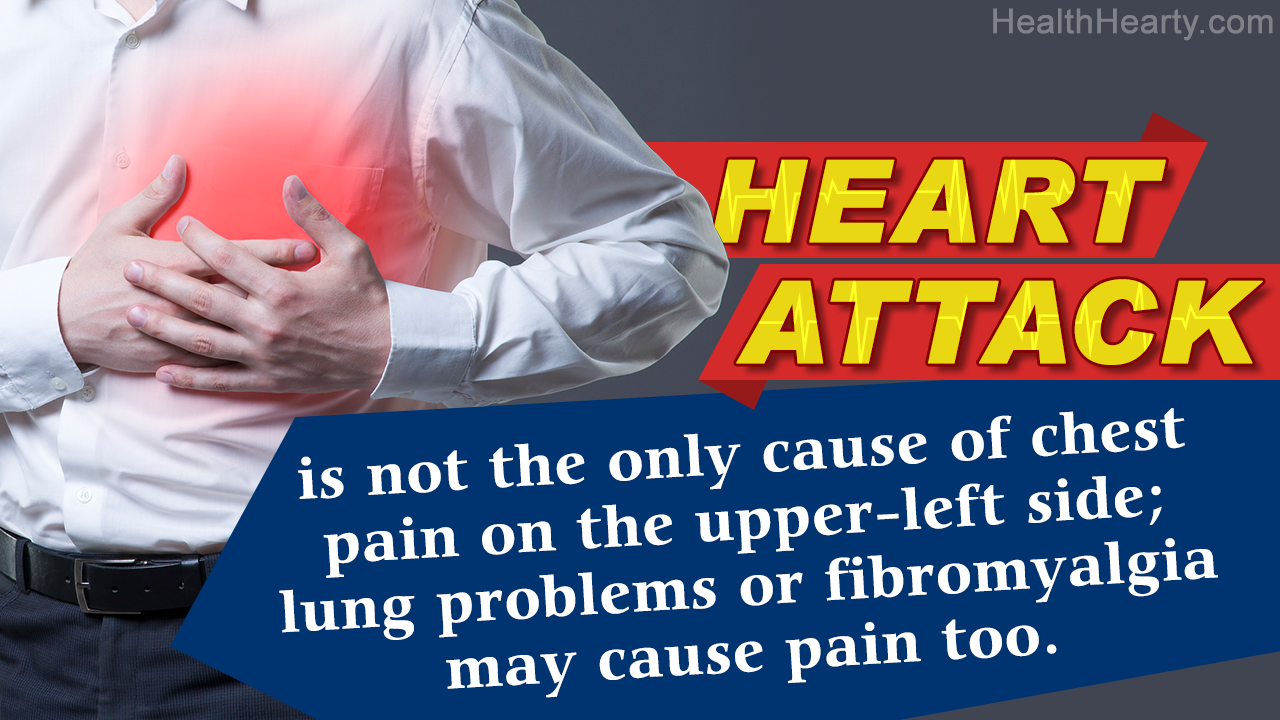
Anyone can suffer from upper-left chest pain any time and it may ring alarm bells for these people. Although you should not panic, you should, at the same time, remember not to neglect the pain.
If the history of emergency medical help calls is studied, after accidents, chest pain is the most common reason, why people call for emergency help. Every year, all around the world, there are millions of patients, who are treated for chest pain. Chest pain can be divided into two types, namely right side chest pain and left side chest pain. However, it is important to remember, that not every chest pain means a heart attack. The point of origin of chest pain can be any one of the organs in the chest, namely heart, lung, or esophagus, or from the components of the chest wall. In some cases, chest pain can also be caused due to problems in the gallbladder or stomach. There have also been cases, where chest pain actually was referred pain. Normally, the point of origin of referred pain is the neck.
Causes of Upper-left Side Chest Pain
Chest pain in the left side can be caused due to a range of health problems. Like I have mentioned previously, understand that many a time, the underlying cause of chest pain may not be related to the heart. Now let’s read on causes of pain in upper-left chest.
Angina
Angina is caused due to hard, thick, cholesterol containing plaques, which gradually build up on the inner walls of the arteries that carry blood to the heart. The plaque narrows the arteries, due to which oxygen-rich blood supply to the heart is restricted. When the blood supply is restricted, it can cause recurrent episodes of chest pain, also called angina pectoris, or cardiac ischemia, or simply angina. Angina pain is particularly common during physical strenuous activity, when the heart rate and pressure on the heart increases and there is demand for more oxygen. In other words, when the amount of oxygen decreases as opposed to the demand, it gives rise to this kind of pain.
Heart Attack
This is one of the highest cause of chest pain. Heart attack (or myocardial infarction) often causes pressure or crushing pain in the chest. The pain may last for a few minutes and it may get distributed to the back, neck, jaw, shoulders, arms, etc. The pain is often seen in the left side. In some cases, patients have also suffered from back pain, due to a heart attack, or the pain can originate in the back and then radiate towards the heart. A heart attack is caused, when fatty plaque ruptures and a blood clot forms on the plaque, which can partially or completely block the artery. More often than not, it is noticed that a heart attack results from a prolonged period of angina. The patients can suffer from dull, burning, or sharp chest pain, or pain on the left side of the heart in general. In most cases, it is often discomfort more than pain. The other symptoms, which are associated with a heart attack include shortness of breath, nausea or vomiting, sweating, dizziness, irregular heartbeat, and excruciating pain which spreads from the chest to the back. It is important to note that in case of a heart attack, the person may not experience pain in the center of the chest.
Coronary Spasm
This condition is also known as Prinzmetal’s angina. When the arteries which supply blood to the heart go into spasm, they cause temporary stopping of the blood flow, which results in chest pain. A person may suffer from this while resting and the condition can coexist with coronary artery disease.
Esophageal Spasm
Pain in the upper-left quadrant of the chest while breathing may be caused due to an esophageal spasm. This condition is not widely seen. The nerves which serve the heart and the esophagus are the same. Disorder of the esophagus makes swallowing difficult and sometimes painful. The muscles, which normally move food down the esophagus are uncoordinated, which results in spasms and pain while breathing and eating, which is confused with chest pain. GERD can also cause pain around the esophageal area.
Gallbladder, Pancreatic, or Lung Problems
Inflammation of the gallbladder or pancreas can cause acute pain. This pain often radiates to the chest and the patient feels pain in the chest. In some cases, the pain may start in the chest itself, especially if the pain is caused due to conditions like ulcer, irritable bowel syndrome, etc. Lung problems like pulmonary embolism, pulmonary hypertension, etc., may also cause chest pain.
Fibromyalgia
If a patient suffers from chronic muscle pain, such as fibromyalgia, he may suffer from chest pain. This pain can be caused by sore muscles and joints. In this condition the muscles in the chest pain, giving it a look of chest pain in the upper-left side.
When a patient suffers from upper-left chest pain, it is important not to panic, but at the same time, you will have to take the required measures to ease the patient of the pain. If the pain is excruciating, it is recommended not to waste any time and seek medical help immediately.
Disclaimer: This HealthHearty article is for educational purposes only and does not intend to be considered as a replacement for an expert medical advice.






